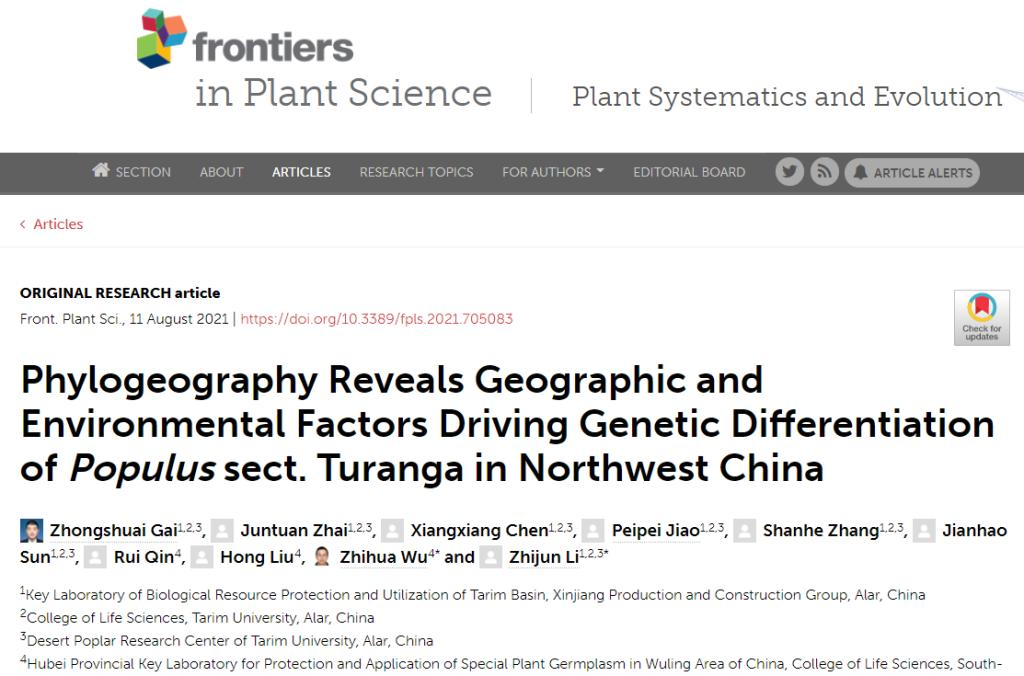Populus euphratica Oliv. and Populus pruinosa Schrenk both belong to the genus of Populus, family of Salicaceae, which are advantaged tree species growing in the desert riversides of the acrid regions around the world and play a key role in maintaining the ecosystem balance of acrid regions, curbing the desertification and protecting the biodiversity. At present, there have been no systematic reports on the genetic differentiation of the two tree species and how they are affected by geographic and environmental factors.
Recently, the team of the Bio-resource Protection and Utilization Engineering Center of the College of Life Science, SCMU and the team led by Professor Li Zhijun of Tarim University have co-published on the journal of “Frontiers in Plant Science” a research paper with the title of “Phylogeography Reveals Geographic and Environmental Factors Driving Genetic Differentiation of Populus sect. Turanga in Northwest China”. The research first elaborated that the geographic isolation and environmental heterogeneity decided the existing genetic structure of Populus group, discovered that the high hereditary diversity of Populus group in south Xinjiang is related with the geographic structure and strong gene flow, provided new theoretical basis for the driving mechanism of their genetic differentiation by geographic and environmental factors, and provided an important genetic basis for the protection of diversity of Populus group. The paper’s first author was doctoral student Gai Zhongshuai co-tutored by SCMU and Tarim University and its joint corresponding authors were Professor Li Zhijun of Tarim University and doctoral student Wu Zhihua from the Bio-resource Protection and Utilization Center of SCMU. It was also another achievement following the publishing of the academic monograph “Research on Physiological and Molecular Mechanisms of Populus euphratica Oliv. and Populus pruinosa Schrenk in Resistance to Draught”, after the College of Life Science of SCMU and Tarim University carried out in-depth cooperation on the diversity of border plants. In 2021, the College of Life Science also carried out border scientific expedition activities on resources including Populus with Tarim University and Southwest University for Nationalities, having left footprints on the habitats of Populus in China. Thanks to the earlier basic work, the regional fund project of 2021 National Foundation of Natural Science declared jointly by doctoral student Wu Zhihua from SCMU and Professor Li Zhijun from Tarim University was approved, which had become an iconic progress in the further research of the roles played by Populus in the extremely acrid ecological systems such as deserts.

Screenshot of the research fruit. Photo provided by Institute for Scientific Research and Development
The team of the Bio-resource Protection and Utilization Engineering Center of the College of Life Science, SCMU has been engaged in the collection, development, utilization and protection of wild and tamed plant resources, and applied technologies such as bioinformatics, molecular genetics and molecular biology to interpret the plants’ adaptive evolution mechanism. It has achieved important headway in the revision of the genus of ChrysospleniumTourn. ex L, the research of Xinjiang Populus and safflower and other characteristic resources, and set up several industry-academy-research cooperation bases in regions like Xinjiang, Qinghai and Tibet.
Link of original text:
https://doi.org/10.3389/fpls.2021.705083
(Editor: Liu Hong Source: Institute for Scientific Research and Development)